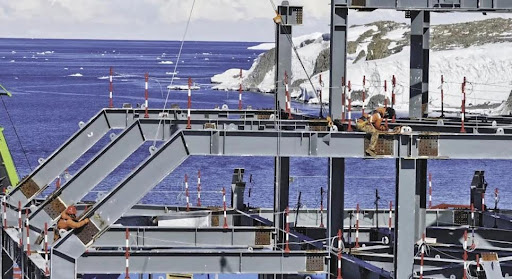By Li Xinping, People’s Daily
As the last glimmers of sunlight faded across the Ross Ice Shelf, Antarctica entered its long polar winter. Against this stark backdrop of ice and snow, China’s Qinling Station stood firm like a sturdy gray ark, already equipped with a microgrid system, hydrogen energy facilities, and a communications network.
Qinling Station is China’s fifth research station on the continent, filling the gap in the country’s scientific presence in the Ross Sea region. At present, 32 construction personnel remain on site through the winter, carrying out interior outfitting and electromechanical installation while ensuring the station’s operation and maintenance.
China’s polar construction efforts date back to the early 1990s, when teams from China Railway Group, China Construction Technology Consulting Group, and other companies began making regular journeys south. Over the past three decades, they have traveled to Antarctica more than 20 times, steadily advancing China’s scientific footprint at the Earth’s southernmost frontier.
Qinling Station is located on Inexpressible Island, where the average temperature hovers around minus 20 degrees Celsius and can plunge to minus 45 degrees. Fierce gales lash the island on more than 100 days each year. To meet these extreme conditions, the station adopted an innovative prefabricated, modular construction approach from the outset: steel structures and functional modules were manufactured in China, shipped south, and assembled on-site like building blocks, ready for immediate use upon assembly.
Since welding is impossible in Antarctica, all steel structures had to be bolted together. “Even turning a screw here is a battle,” recalled Xie Shuaishuai, a young assembler born after 2000. Wearing gloves to stave off frostbite, he found they quickly became damp with sweat, froze stiff in the wind, and stuck to his tools. “You have to warm your gloves, put them back on, and repeat the process again and again,” he said. In the end, he tightened 11,000 screws in this way.
The construction of Qinling Station officially began on December 16, 2023, during China’s 40th Antarctic expedition. In less than 30 days, the steel structure of the main building was completed. Within 60 days, the main construction was in place. The project set five records in Antarctic station construction: the largest workforce deployed, the greatest volume of materials handled, the largest single building erected, the harshest conditions endured, and the fastest construction achieved.
When the 41st Antarctic expedition departed on November 1, 2024, more than 100 builders from China Railway Group and China Construction Technology Consulting Group joined the mission. “Most had already taken part in the 40th expedition, and some had worked on more than 10 Antarctic projects,” said team leader Luo Huangxun.
Luo himself joined China’s polar construction team in 2007. Over the past 18 years, he has completed 13 Antarctic projects, at times spending up to 17 consecutive months on the continent.
After a grueling 29-day, 7,570-nautical-mile voyage through equatorial heat and the turbulent westerlies, the expedition reached Chinese research base Zhongshan Station on Nov. 30, 2024. There, a massive unloading operation began: cranes worked continuously as crew members formed human chains to transfer materials piece by piece. In less than five days, nearly 6,000 tons of cargo were brought ashore.
Construction then moved into full swing. “This time, we introduced the most advanced building methods to Antarctica, integrating design, manufacturing, transportation, and on-site assembly,” Luo said.
A key innovation was the extensive use of digital simulation.
“Antarctica is too remote, and transport capacity too limited. Any unexpected problem could derail the schedule,” explained project manager Zheng Di of China Railway Construction Engineering Group. To address this problem, the team used building information modeling (BIM) to refine designs and simulate optimized construction plans.
One example was the station’s electromechanical system, which required more than 100,000 meters of pipelines. By breaking the system into modular units through digital simulation, the team reduced complexity and boosted efficiency by 72 percent.
The energy system is now largely complete, comprising wind turbines, solar panels, battery storage, hydrogen production and storage, and hydrogen fuel power generation. “These renewable systems will provide Qinling Station with a sustainable and reliable energy supply,” Zheng noted. Even during the long polar night, they can supply at least 14 days of continuous power at 30 kilowatts.
When the summer construction season ended, more than 30 crew members remained behind to keep the station running through the Antarctic winter. “Spending the winter here is far more challenging than working during the summer season,” said Luo, who has already endured two Antarctic winters. “We face 58 days of unbroken darkness. But whenever I see the station gradually taking shape through our efforts, I feel nothing but pride and accomplishment.”
Now 59, Luo is often asked whether he plans to return again. His answer remains firm: “As long as I’m needed, and as long as I’m fit, I’ll be right here with the team in Antarctica.”














